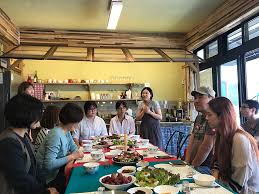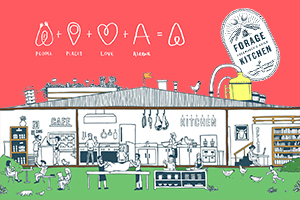List
Story > NEWS > Detail
[News] The Concept, Background and Development Process of a Shared Kitchen -2
Since the end of the 19th century, the common kitchen, which has appeared in Britain and other European countries, has performed its role and function as it sits inside a shared housing complex. In Europe, where there have been a lot of collective housing since its entry into an industrial society, a common kitchen emerged as part of the nascent social reform and women's movement. It claimed that individuals should not prepare food with the intention of "liberating women from household chores and avoiding wasteful cooking," and provided a service to arrange shared kitchens or to prepare and deliver food from shared kitchens. While the case of Europe developed from the perspective of improving the common and universal community life of families, the U.S. used a community-sharing space to efficiently satisfy the housing needs of a small number of low-income, disabled, and senior citizens, which were all social problems in the U.S.

In the 19th and early 20th centuries, in the United States, there were many houses with shared spaces and shared facilities, but in houses designed to help people live in cooperation, common household facilities or restaurants were located in the central part of the housing, except for private spaces such as bedrooms. Also, homes that currently have shared spaces and facilities in the U.S. are developing into a suitable form for those with special needs, such as students, the elderly and the socially disadvantaged, and their key functions are to support health and life. The shared space of housing in response to vulnerable social services is particularly focused on the function of the kitchen and is aimed at meeting the basic needs of the diet as well as providing stability and helping with the functions of rest and society. As the aging population continues, many developed countries are creating various types of shared kitchen and using it for the welfare of the elderly. The importance of open space available together within the community has evolved under the name Community Kitchen and in the UK the community meal program as a program for senior citizens has a similar nature to the shared kitchen that this study would like to discuss. The name of a meeting for senior citizens in the UK is mainly called a lunch club, whose operation can be classified into six types. In other words, local governments, volunteer groups, local communities, interest groups, community cafes, and other private organizations are the main players in operation. Although the operation methods vary depending on the main body, most of the dishes are cooked in the kitchen or delivered from outside. Such a common kitchen in the U.K., which was created for the welfare of the elderly, was initially designed to cook in one place and deliver meals to the home, but it is developing into a form that allows users to actively participate in a designated community space in consideration of their mental health.

In the case of Japan, which is a good example of the Korean village-building project, a common kitchen was created as a result of the development and regeneration of residential areas. Hyogo Prefecture, Kobe City, Tamur District, Akashi City, and Nakakkyo-gu, Kyoto, which are also considered successful cases of urban renewal in Japan, have a common kitchen where residents can visit, dine, and talk with each other at any time. People gathered here not only eat, but also spend time meeting their neighbors, using facilities in various communities. The development of the common kitchen in the United States is also related to the production and consumption of The Rural Development Assistance Program, which the federal government has put forward as a policy to promote direct agricultural trade and local food consumption, includes the Community Facilities Program, one of which is the Community Kitchen.

Launched in 2012 through the U.S. crowdfunding website KickStarter, Storage Kitchen sees the kitchen as a kind of community hub and centers around it, creating a space for interacting and networking as well as sharing food. Not only does he share his kitchen, he also has the concept of incubating, which means helping a young man or a housewife chef who wants to start her own restaurant, and is still actively operating it. Australia's first community Kitchen was introduced in 2004 in the Frankston area and is recognized as a fraternity group for people of the same mind, regularly coming together to cook cheap and nutritious meals. This is somewhat different from the cases in the U.K. and the U.S. where participants can either bring their own cooked food to one place and have a conversation while eating together or jointly purchasing quality ingredients to enjoy the economic benefits of saving money by cooking in the same place.
Since the end of the 19th century, the common kitchen, which has appeared in Britain and other European countries, has performed its role and function as it sits inside a shared housing complex. In Europe, where there have been a lot of collective housing since its entry into an industrial society, a common kitchen emerged as part of the nascent social reform and women's movement. It claimed that individuals should not prepare food with the intention of "liberating women from household chores and avoiding wasteful cooking," and provided a service to arrange shared kitchens or to prepare and deliver food from shared kitchens. While the case of Europe developed from the perspective of improving the common and universal community life of families, the U.S. used a community-sharing space to efficiently satisfy the housing needs of a small number of low-income, disabled, and senior citizens, which were all social problems in the U.S.

In the 19th and early 20th centuries, in the United States, there were many houses with shared spaces and shared facilities, but in houses designed to help people live in cooperation, common household facilities or restaurants were located in the central part of the housing, except for private spaces such as bedrooms. Also, homes that currently have shared spaces and facilities in the U.S. are developing into a suitable form for those with special needs, such as students, the elderly and the socially disadvantaged, and their key functions are to support health and life. The shared space of housing in response to vulnerable social services is particularly focused on the function of the kitchen and is aimed at meeting the basic needs of the diet as well as providing stability and helping with the functions of rest and society. As the aging population continues, many developed countries are creating various types of shared kitchen and using it for the welfare of the elderly. The importance of open space available together within the community has evolved under the name Community Kitchen and in the UK the community meal program as a program for senior citizens has a similar nature to the shared kitchen that this study would like to discuss. The name of a meeting for senior citizens in the UK is mainly called a lunch club, whose operation can be classified into six types. In other words, local governments, volunteer groups, local communities, interest groups, community cafes, and other private organizations are the main players in operation. Although the operation methods vary depending on the main body, most of the dishes are cooked in the kitchen or delivered from outside. Such a common kitchen in the U.K., which was created for the welfare of the elderly, was initially designed to cook in one place and deliver meals to the home, but it is developing into a form that allows users to actively participate in a designated community space in consideration of their mental health.

In the case of Japan, which is a good example of the Korean village-building project, a common kitchen was created as a result of the development and regeneration of residential areas. Hyogo Prefecture, Kobe City, Tamur District, Akashi City, and Nakakkyo-gu, Kyoto, which are also considered successful cases of urban renewal in Japan, have a common kitchen where residents can visit, dine, and talk with each other at any time. People gathered here not only eat, but also spend time meeting their neighbors, using facilities in various communities. The development of the common kitchen in the United States is also related to the production and consumption of The Rural Development Assistance Program, which the federal government has put forward as a policy to promote direct agricultural trade and local food consumption, includes the Community Facilities Program, one of which is the Community Kitchen.

Launched in 2012 through the U.S. crowdfunding website KickStarter, Storage Kitchen sees the kitchen as a kind of community hub and centers around it, creating a space for interacting and networking as well as sharing food. Not only does he share his kitchen, he also has the concept of incubating, which means helping a young man or a housewife chef who wants to start her own restaurant, and is still actively operating it. Australia's first community Kitchen was introduced in 2004 in the Frankston area and is recognized as a fraternity group for people of the same mind, regularly coming together to cook cheap and nutritious meals. This is somewhat different from the cases in the U.K. and the U.S. where participants can either bring their own cooked food to one place and have a conversation while eating together or jointly purchasing quality ingredients to enjoy the economic benefits of saving money by cooking in the same place.



